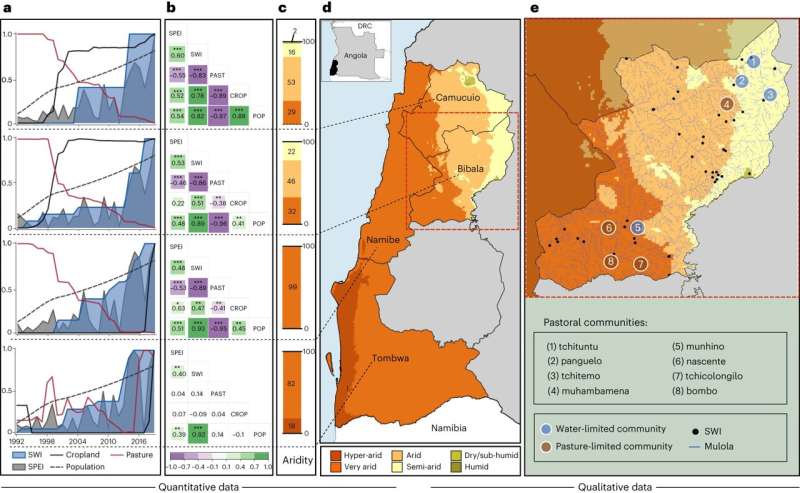This article has been reviewed according to Science X's editorial process and policies. Editors have highlighted the following attributes while ensuring the content's credibility:
fact-checked
trusted source
proofread
Increased access to water may be a threat to nomadic livestock farmers in the long term

Increasing access to water in extremely arid parts of sub-Saharan Africa can help nomadic livestock farmers in the short term. However, in the long run, it may lead to serious consequences for their livelihoods. This is shown by new research from Uppsala University published in Nature Climate Change.
"When you increase access to water in arid areas, often as an urgent emergency measure, it becomes easier for livestock owners to stay there longer. However, that in turn increases the demand for water and pasture for their animals, to a level that isn't there, and that risks having a severe impact on the population and reducing their resilience to drought and climate change," says Giuliano Di Baldassarre, Professor of Environmental Analysis at Uppsala University.
Millions of farmers in sub-Saharan Africa are affected by drought, which often leads to water crises, famine and migration. Drought is particularly disastrous in drylands, which typically experience great variation in precipitation, with short rainy periods followed by dry spells lasting for months. The communities in these areas mostly consist of nomadic livestock farmers. Seasonal movements of herds are the traditional strategy used by nomadic livestock farmers around the world to deal with drought.
In recent times, initiatives to improve the water infrastructure in arid areas have become more common. One of the strategies is to make deep wells and boreholes to extract water. This is often an emergency measure to save the animals' lives during drought.
In a new study, led by Uppsala University, researchers have investigated how the new sources of water affect nomadic communities. They have used qualitative methods of anthropological research in large arid areas in various African countries, and quantitative methods, such as data analysis and socio-hydrological modeling, in Angola.
In their research, the researchers have compared how the overall conditions in drylands look in terms of the extent of drought, access to water, soil conditions and population size. They have examined statistics from the years 1954–2018 on the boreholes, shallow and deep wells created, when they were made and for what purpose.
Most of the water infrastructure created had multiple functions and was intended both for household use and for livestock and irrigation. During 2021, the researchers followed eight nomadic communities in Angola and conducted in-depth interviews with 24 focus groups.
The study shows that when access to water improves, thanks to new wells and boreholes, the need for water grows further. Both the human population and the livestock need more water, and the animals need more pasture.
"It is not possible to guarantee access to water and there is a risk of even greater problems for livestock farmers if they settle more permanently in one place. Our study shows that measures aimed solely at increasing the water supply, without effective management, risk threatening the resilience of nomadic communities to drought and climate change, and this is happening at a time when drought is expected to increase in many regions in the coming decades," says Di Baldassarre.
More information: Luigi Piemontese et al, Over-reliance on water infrastructure can hinder climate resilience in pastoral drylands, Nature Climate Change (2024). DOI: 10.1038/s41558-024-01929-z
Provided by Uppsala University


















